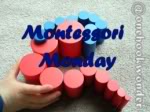If you have the determination to use the Montessori approach with your children at home, you don't always need to spend money. Yes, at least half of a Montessori education is based on using specialized materials in the classroom, but what about the other half? At least half of the Montessori Recipe is the approach of the teacher (also called "guide" or "director"). You are helping the whole child--mind, body and soul. You are helping the soul that is coming to life!
 |
| Get your children involved in all of the household tasks. For the small child, his life is his work and his work is his life! |
That should be good news to those of you who tell me, "I don't have time to run all over town to put together these materials!" or "I have 3 (or 4 or 5 or N) older children to homeschool. I don't have time to devote to teaching my toddler one-on-one!" or "I couldn't possibly commit a big part of my house to a Montessori classroom!" Knowing that the way we approach teaching and the way we care for our children's learning environment is at least half of the challenge, we should be encouraged!
 |
Children need to work with their hands + The car mats need to be scrubbed = Work.
Maria Montessori said, "The hand is the instrument of the intellect," and, "Never give more to the mind than to the hand." |
 |
| Child needs to eat + She likes to pick the tomatoes = Work. |
I've made a list of A Dozen Do's to the Montessori Approach, but keep in mind that in the world of Montessori the word "work" is used to mean a specific activity offered to practice, illustrate or teach a specific concept. In my captions I use the word to mean something similar, but I purposely used photos of activities that are NOT classic Montessori works. This is to emphasize that
you don't always need special materials to raise your children according to the Montessori philosophy.
Be a Sherlock Holmes
You need to be a keen observer of the child. You need to see what his needs are and try to offer the next challenge. Know basic child development and the
11 Human Tendencies.
Teaching Them to be Problem Solvers
Help her to overcome problems by being resourceful and independent. Think of Robinson Crusoe. The child has the same inner drive to survive and progress!
Let Them Do It Themselves
Never do for the child what he can do for himself. "Every useless aid arrests development," Montessori said. If all is going well, you should fade into the woodwork!
Let Them Make Mistakes
Give her freedom within limits and let her learn from consequences. Especially the 2- to 4-year-olds need the chance to carry heavy or fragile things!
Follow the Child
You connect the child to the work. Pay close attention to how well he completes a task and whether you need to tailor the work to his individual needs.
Focus on Self-Control and Development of the Will
The focus on practical life activities will help the child to work and to choose. She will gradually grow in mastery. You need to be a good example of self control, especially when it comes to anger. When it comes to her behavior, think of the 3D's of intervention: stop whatever is destructive, disturbing others' work, or distracting.
Break Tasks Down into Discrete Steps
We don't realize how easy it is for us adults to combine many steps of a task into a single action. It's confusing to a child. To show him how to accomplish a task (like washing a table) we need to break the job into simple discrete steps. Washing a table is a great example of an engaging work that can be broken into 73 steps!
Slow Down
Focus on the process and perfecting the work. As my mentor taught me: "To hurry is to harass!"
Use Fewer Words When Demonstrating
Mostly we model and the child learns from watching us.
Keep Looking for their Next Challenge
Once the child has mastered a task, give her the next challenge. Think one step ahead.
Focus on the "Real"
In contrast to cartoons and fantasy, we focus on the awe, joy and wonder of what is real. From 0 - 6 steep them in reality, when they can assimilate a huge amount of facts and information.
Emphasize Grace and Courtesy
We practice manners and how to get along--which are concepts rooted in charity--at all times. As Montessori said, love is one of the essential ingredients to the classroom. When grace and mercy are present, children aren't afraid to make mistakes.
 |
| Her birthday cake being made = Fascinating! |
 |
| Children learn through all of their senses. |
 |
| A child's natural joy can be fuel for learning. |
 |
| "Look! A baby bunny!" Awe and wonder at God's creation comes naturally to children. |
 |
| Water and pouring + playing in the pool = Work/Play |




















































